
Reimagining the Underworld

It’s often said that the college years are a time to explore new paths, and in the process, perhaps discover one’s true passion. For Hao Tang, a studio art major from Hangzhou, China, Wooster certainly provided that opportunity.
Standing before the monumental oil painting that he created as part of his senior I.S., it’s hard to believe that just four years ago, he was taking an introductory drawing class with Amber Kempthorn. The eight-foot-tall canvas spans nearly the full width of the gallery: 35 feet from end to end. It took two months to plan and four to paint. The subject matter is a reimagining of Buddhist beliefs and myths concerning death, rebirth, and salvation.
“The painting centers on a myth of the underworld and focuses on Meng Po, the Lady of Forgetfulness, who mediates memory and forgetting in the circle of life and rebirth,” Hao says. “In the myth, Meng Po would offer the soup of oblivion to the dead souls. While some souls would choose to accept the soup and get reborn, others would choose to remember their past lives at the expense of being reincarnated.”
Hao, who attended high school in Buffalo before coming to Wooster, says the work symbolizes his bi-cultural background, from his choice of medium to his representation of Meng Po and the other figures in the piece. “Oils are still relatively new in Chinese art – about a hundred years or so – compared with in Western art,” he says. Dizang Bodhisattva, the sovereign of the underworld, is depicted using a much more muscular, sculptural, Western approach than in traditional Chinese art, as are other figures in the painting. “Instead of replicating the conventional imagery, the painting accentuates a more disturbing, ambiguous, and sensual demeanor in the visual narrative.”
Tracy Cosgriff, an assistant professor of art, “gave me lots of texts to read, and helped me find my own voice in the end,” while Professor Marina Mangubi, his I.S. advisor, “posed lots of questions, but never imposed ideas on me. She let me think it out.” He calls Mangubi “the most influential figure in my college life here. Without her, I would not be at this stage at this time.”
Hao is returning to China, as is his monumental painting, after commencement. He plans to take a gap year to think about what comes next. “I want to learn more about Chinese history,” he says. “I feel more attached to my Chinese origins and want to explore more of it.” Of his time at Wooster, he says, “I was able to find my own dream, my own passion here, without distraction. Wooster helped hone that dream. There’s a real community here.”
Posted in Independent Study on May 20, 2019.
Related Posts
Related Areas of Study
Art - Studio Art
Studio space, small classes with talented instructors, and the strong foundation that comes with a liberal arts education.
Major Minor

